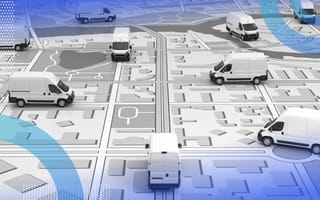The automotive industry, like many others, is increasingly under pressure to increase its environmental sustainability, hence the push for electric and hybrid vehicles. But even before such solutions — and the infrastructure to support them — become widespread and affordable, vehicle fleet managers can concentrate on something that could be far more simple: reducing the number of wasted, non-revenue-producing miles put on vehicles. This approach should not be discounted, and can go a long way in conserving fuel and reducing carbon emissions.
While estimates vary, many in the industry say that at least 20 percent of the miles put on fleet vehicles, whether rental cars or delivery trucks, don’t actually produce revenue. Rather, they are used for driving empty trucks between loads, taking vehicles to repair shops, and moving rental or fleet vehicles around to meet user demand. In some cases, simply better planning can help cut back on these miles. The industry needs to turn to technology, namely AI-assisted tools, to help more efficiently handle all the moving parts of fleet management to make sure that miles — and polluting or expensive fuels — are not wasted. AI-powered technologies can be especially helpful in finding even the smallest ways to save fuel; put together, these, too, can add up and make a big difference in cutting emissions while also improving a fleet’s bottom line.
Here are the three ways AI and data can help fleets be more sustainable. These solutions, although they do require investment, will likely cut costs as well.
3 Ways AI Can Help Reduce Carbon Emissions in Vehicle Fleets
- Conducting remote vehicle inspections
- Planning better, more efficient routes
- Improving fuel-intensive driver behaviors
1. Remote Vehicle Inspections
When vehicles in fleets are damaged, just like any other vehicle, they must be taken to repair facilities. This can sometimes be a drawn-out process that includes getting an estimate, making sure needed parts are in stock, and more; sometimes vehicles that are still driveable need to be taken to a repair location multiple times, once for an estimate and then again for the actual repair.
One way to cut down on journeys to repair shops, or shorten the time a car is in a shop, is to inspect and evaluate damage remotely, through mobile phone apps that can quickly use computer vision, machine learning, and other types of AI to assess the cost of the repairs and which parts are needed. They can also help detect mechanical problems and send alerts when routine maintenance is needed, also contributing to fuel overall fuel efficiency.
Remote inspections can also be used to replace other off-site inspections, such as those required for insurance, license plate renewals, or when looking to sell a car that is part of a fleet. In fleets of shared vehicles, remote inspections can eliminate the need for employees to travel out to the locations of cars to periodically check up on them.
In addition to saving fuel and miles on a car, remote inspections can also save employees’ time, resulting in increased efficiency. Another emerging benefit of remote AI-powered inspections is that they are more objective and consistent than human inspections, and can therefore be more accurate.
2. Planning Better Routes
When designing routes for delivery or cargo purposes, it’s not just about avoiding traffic in order to save fuel and cut down on carbon emissions. AI solutions can also be deployed to minimize the number of miles that fleets of trucks or other delivery vehicles are driving while empty. For example, the startup trucking company AI Fleet’s algorithms allow it to accept loads for its drivers only when there is another load ready to go at the destination, and makes sure that drivers’ last loads before their days off are delivered near their homes or the location they will spend their free days.
Such technology makes trucking not only more environmentally sustainable, but helps guarantee that companies, as well as drivers, are actually making revenue while on the road, and not spending time driving empty trucks or idling while waiting for new loads. This is increasingly important now, as trucking and delivery companies face a shortage of drivers, which is contributing to ongoing shipping bottlenecks and delays.
3. Improving Driver Behavior
Driver behavior can also have a large impact on fuel use and efficiency. Speeding, rapid acceleration, detours, and idling all result in wasted fuel. AI-powered telematics systems can help reduce, or at least track, such behaviors. A Frost & Sullivan study found that implementing telematics saved fleets between 20 and 25 percent on fuel costs. Those savings also mean less carbon going into the air and contributing to climate change.
Vehicles account for 29 percent of total greenhouse gas emissions in the United States. Reducing this is vital; it is also, admittingly, a tall order. That’s why in addition to legislation and government subsidies, small, independent steps are also important; all these incremental measures do add up and make a difference.





